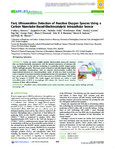Fast, Ultrasensitive Detection of Reactive Oxygen Species Using a Carbon Nanotube Based-Electrocatalytic Intracellular Sensor
| dc.contributor.author | Rawson, FJ | |
| dc.contributor.author | Hicks, J | |
| dc.contributor.author | Dodd, N | |
| dc.contributor.author | Abate, W | |
| dc.contributor.author | Garrett, DJ | |
| dc.contributor.author | Yip, N | |
| dc.contributor.author | Fejer, Gyorgy | |
| dc.contributor.author | Downard, AJ | |
| dc.contributor.author | Baronian, KHR | |
| dc.contributor.author | Jackson, SK | |
| dc.contributor.author | Mendes, PM | |
| dc.date.accessioned | 2017-03-10T15:47:53Z | |
| dc.date.available | 2017-03-10T15:47:53Z | |
| dc.date.issued | 2015-10-28 | |
| dc.identifier.issn | 1944-8244 | |
| dc.identifier.issn | 1944-8252 | |
| dc.identifier.uri | http://hdl.handle.net/10026.1/8607 | |
| dc.description.abstract |
Herein, we report a highly sensitive electrocatalytic sensor-cell construct that can electrochemically communicate with the internal environment of immune cells (e.g., macrophages) via the selective monitoring of a particular reactive oxygen species (ROS), hydrogen peroxide. The sensor, which is based on vertically aligned single-walled carbon nanotubes functionalized with an osmium electrocatalyst, enabled the unprecedented detection of a local intracellular "pulse" of ROS on a short second time scale in response to bacterial endotoxin (lipopolysaccharide-LPS) stimulation. Our studies have shown that this initial pulse of ROS is dependent on NADPH oxidase (NOX) and toll like receptor 4 (TLR4). The results suggest that bacteria can induce a rapid intracellular pulse of ROS in macrophages that initiates the classical innate immune response of these cells to infection. | |
| dc.format.extent | 23527-23537 | |
| dc.format.medium | Print-Electronic | |
| dc.language | en | |
| dc.language.iso | eng | |
| dc.publisher | American Chemical Society (ACS) | |
| dc.subject | intracellular sensor | |
| dc.subject | electrocatalytic sensor | |
| dc.subject | carbon nanotubes | |
| dc.subject | reactive oxygen species | |
| dc.subject | hydrogen peroxide | |
| dc.subject | macrophage cells | |
| dc.title | Fast, Ultrasensitive Detection of Reactive Oxygen Species Using a Carbon Nanotube Based-Electrocatalytic Intracellular Sensor | |
| dc.type | journal-article | |
| dc.type | Journal Article | |
| dc.type | Research Support, Non-U.S. Gov't | |
| plymouth.author-url | https://www.webofscience.com/api/gateway?GWVersion=2&SrcApp=PARTNER_APP&SrcAuth=LinksAMR&KeyUT=WOS:000363994700022&DestLinkType=FullRecord&DestApp=ALL_WOS&UsrCustomerID=11bb513d99f797142bcfeffcc58ea008 | |
| plymouth.issue | 42 | |
| plymouth.volume | 7 | |
| plymouth.publication-status | Published | |
| plymouth.journal | ACS Applied Materials & Interfaces | |
| dc.identifier.doi | 10.1021/acsami.5b06493 | |
| plymouth.organisational-group | /Plymouth | |
| plymouth.organisational-group | /Plymouth/Faculty of Health | |
| plymouth.organisational-group | /Plymouth/Faculty of Health/School of Biomedical Sciences | |
| plymouth.organisational-group | /Plymouth/REF 2021 Researchers by UoA | |
| plymouth.organisational-group | /Plymouth/REF 2021 Researchers by UoA/UoA01 Clinical Medicine | |
| plymouth.organisational-group | /Plymouth/Research Groups | |
| plymouth.organisational-group | /Plymouth/Research Groups/Institute of Translational and Stratified Medicine (ITSMED) | |
| plymouth.organisational-group | /Plymouth/Research Groups/Institute of Translational and Stratified Medicine (ITSMED)/CBR | |
| plymouth.organisational-group | /Plymouth/Users by role | |
| plymouth.organisational-group | /Plymouth/Users by role/Academics | |
| plymouth.organisational-group | /Plymouth/Users by role/Researchers in ResearchFish submission | |
| dc.publisher.place | United States | |
| dc.identifier.eissn | 1944-8252 | |
| dc.rights.embargoperiod | Not known | |
| rioxxterms.versionofrecord | 10.1021/acsami.5b06493 | |
| rioxxterms.licenseref.uri | http://www.rioxx.net/licenses/all-rights-reserved | |
| rioxxterms.type | Journal Article/Review | |
| plymouth.funder | Establishment of non-transformed, continuously growing, alternatively activated mouse macrophage cell lines::NC3Rs |


